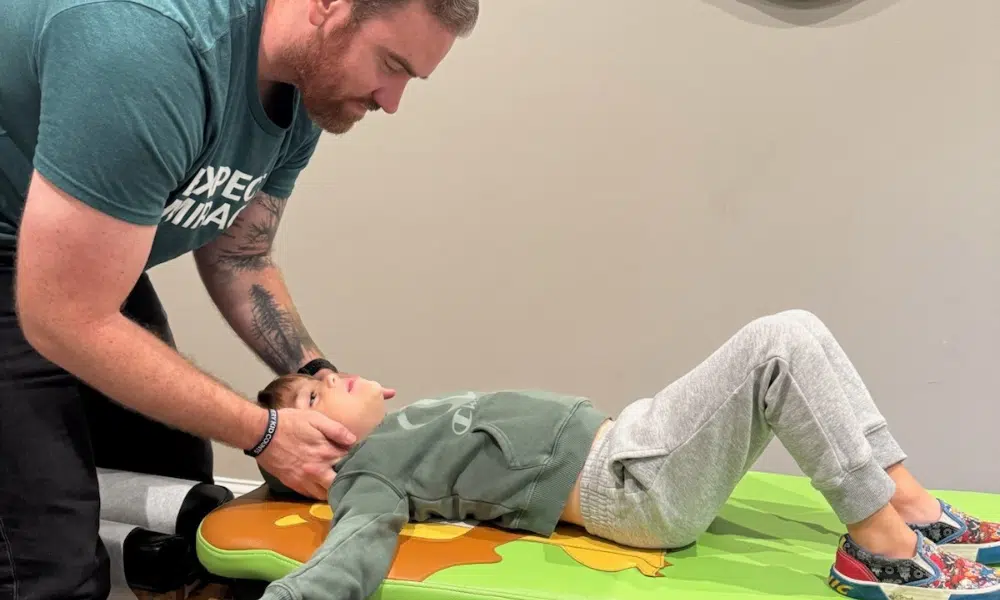You’ve started Neurologically-Focused Chiropractic Care for your child, and for the first time, you feel hopeful — the plan makes sense, and you’re seeing those small but meaningful steps forward. Maybe they’re sleeping a bit better, or their meltdowns aren’t quite as intense. But between appointments, you wonder: Is there anything I can do at home to help?
The answer is yes.
Supporting your child’s nervous system doesn’t require expensive equipment, complicated protocols, or hours of extra work. It’s about small, intentional choices that work with their body’s natural healing process — not against it.
Neurologically-Focused Chiropractic Care is removing the interference and helping your child’s nervous system get unstuck. What you do at home creates the environment where that healing can take root and grow. In this article, we’ll walk through practical steps you can take, from sleep routines to movement to nutrition, that complement your child’s care without overwhelming their system.
Understanding the Foundation: How Neurologically-Focused Chiropractic Care Works
Before we talk about what you can do at home, it helps to understand what’s happening during your child’s chiropractic visits, and why your role matters so much.
The nervous system acts like an air traffic controller for your child’s entire body. It coordinates sleep, digestion, immunity, movement, behavior, and emotional regulation. When everything is working smoothly, your child can adapt to stress, process sensory input, and develop on track.
But when a child goes through what we call the “Perfect Storm,” prenatal stress, birth trauma, early illness, antibiotics, toxin exposure, research shows their nervous system can get stuck in sympathetic dominance, or fight-or-flight mode. This creates tension and dysregulation, where the body has a difficult time regulating even day to day functions.
The result? Sleep struggles, digestive issues, frequent illness, sensory challenges, anxiety, or developmental delays.
Neurologically-Focused Chiropractic care uses gentle adjustments and advanced INSiGHT scans to locate and release those stuck stress patterns. It’s not about caring for the symptoms. It’s about restoring the nervous system’s ability to regulate, heal, and function the way it’s designed to.
Between adjustments, your child’s nervous system is actively reorganizing and healing. What happens at home, how they sleep, eat, move, and experience their environment, either supports that process or works against it. You’re not responsible for “fixing” anything. You’re simply creating the conditions where healing can happen naturally.
The Golden Rule: Consistency Over Intensity
One of the biggest mistakes parents make is doing too much, too fast. We totally get it, you want to see progress, and when you learn about something that might help, you want to implement it immediately.
But a stressed nervous system is like a computer with too many tabs open. Everything slows down. Adding more interventions, more therapies, more changes all at once can actually overload the system further, causing what looks like regression or increased meltdowns.
This is why consistency matters more than intensity. Small, regular practices done daily will always outperform aggressive changes done sporadically. Your child’s nervous system needs predictability and rhythm to feel safe enough to heal.
Signs Your Child’s Nervous System Is Overwhelmed:
- Increased meltdowns or emotional outbursts
- More difficulty falling asleep or staying asleep
- Regression in skills they’d recently mastered
- Heightened sensitivity to sounds, textures, or transitions
- More frequent illness or digestive issues
- Increased stimming or self-soothing behaviors
If you notice these signs, it’s often time to simplify. Pull back on extracurricular activities, reduce screen time, create more downtime, and let their system catch up. Sometimes the kindest thing you can do is create space for rest.
Sleep: The Foundation of Healing
If there’s one thing that will make the biggest difference in supporting your child’s nervous system, it’s sleep. Restorative sleep is when the brain repairs cellular components, processes emotions, clears toxins, and repairs the body.
The key is creating a consistent sleep routine that signals to your child’s nervous system that it’s safe to rest. This means the same bedtime every night, the same wind-down activities, and the same environment. Predictability helps the nervous system shift from Sympathetic Nervous System (alert) mode to Parasympathetic Nervous System (rest and digest) mode.
Simple Sleep Support Strategies:
- Set a consistent bedtime and wake time, even on weekends
- Start the wind-down routine 30-60 minutes before bed (dim lights, calm activities, no screens)
- Keep the bedroom cool, dark, and quiet
- Use white noise if helpful for blocking out household sounds
- Avoid stimulating activities, sugar, or screen time within two hours of bedtime
As your child progresses through chiropractic care, sleep often improves naturally. Your job is simply to protect that sleep window and give their body the chance to do its deepest healing work.
Movement and Play: Building Resilience Through the Body
Movement isn’t just about burning energy, it’s about building neural connections, processing sensory input, and teaching the nervous system how to regulate. When kids move, they’re literally wiring their brains.
But not all movement is created equal. High-intensity sports and overscheduled activities can actually stress the nervous system further. What your child needs is unstructured, exploratory movement that feels like play.
Think: climbing trees, rolling down hills, building forts, dancing in the living room, playing in water or sand, taking long walks, riding bikes. These activities engage the vestibular system (balance), proprioception (body awareness), and motor planning, all of which support nervous system development.
Movement Ideas That Support Regulation:
- Outdoor play in nature (the most regulating environment for kids)
- Animal walks (bear crawls, crab walks, frog jumps)
- Pushing or pulling heavy objects (wheelbarrows, wagons, furniture)
- Swinging, spinning, or hanging from bars
- Gentle stretching before bed
The goal isn’t to add another item to your to-do list. It’s to build movement into your day in ways that feel natural and fun. A 20-minute walk after dinner does more for your child’s nervous system than an hour of structured sports practice.
Creating a Calm Environment: Reducing Nervous System Stress
Your home environment has a direct impact on your child’s ability to regulate. A chaotic, overstimulating space keeps the nervous system on high alert. A calm, predictable environment helps it relax.
Start by observing your home through your child’s sensory experience. Is the TV always on in the background? Are there bright overhead lights? Is there clutter everywhere they look? These small stressors add up and keep the nervous system working overtime.
Ways to Create a Calmer Home:
- Use soft lighting (lamps instead of overhead lights) in the evening
- Minimize background noise (TV, music, constant talking)
- Declutter play spaces so they feel manageable, not overwhelming
- Create a “calm corner” with soft blankets, pillows, or sensory tools
- Give warnings before transitions (“In five minutes, we’ll clean up for dinner”)
- Build in quiet time or rest periods during the day
Calm environments don’t mean silent or boring. They mean predictable, manageable, and soothing. When your child’s nervous system isn’t working so hard to process sensory input, it has more capacity to heal.
Nutrition and Supplementation: Feeding the Nervous System
What your child eats directly impacts how their nervous system functions. The brain and nervous system rely on specific nutrients to build neurotransmitters, reduce inflammation, and support communication between cells.
Focus on whole foods that provide the building blocks the nervous system needs. Prioritize healthy fats (the brain is 60% fat), quality protein, and nutrient-dense vegetables. Reduce processed foods, artificial dyes, and excess sugar, all of which can trigger inflammation and dysregulation.
Key Nutrients That Support Nervous System Health:
- Omega-3 fatty acids: Found in fatty fish (salmon, sardines), flaxseed, chia seeds, and walnuts. Supports brain well-being and reduces inflammation.
- Magnesium: Found in leafy greens, nuts, seeds, and whole grains. Helps calm the nervous system and supports sleep.
- B vitamins: Found in eggs, meat, leafy greens, and legumes. Essential for neurotransmitter production and nerve function.
- Probiotics: Found in yogurt, kefir, sauerkraut, and fermented foods. Supports gut health, which directly impacts nervous system regulation through the gut-brain axis.
If your child is a picky eater or has gut issues that limit absorption, supplementation can help bridge the gap. Omega-3 (fish oil or algae oil), magnesium (powders or gummies work well for kids), and a quality probiotic are three of the most impactful supplements for nervous system support.
Always talk with your healthcare provider before starting new supplements to ensure proper dosing and quality.
Observing and Responding to Your Child’s Cues
Here’s the most important thing you can do at home: pay attention. Your child’s body is constantly communicating what it needs. The more you observe and respond to their cues, the more you support their nervous system’s natural ability to regulate.
This means noticing when they’re getting overwhelmed before a full meltdown happens. It means recognizing that the tantrum after school isn’t just “bad behavior,” it’s a nervous system that’s been holding it together all day and finally feels safe enough to release. It means understanding that some days will feel like progress, and other days will feel like setbacks, and both are part of the healing process.
Questions to Ask Yourself as You Observe:
- Is my child sleeping better or worse than last week?
- Are they having more or fewer meltdowns?
- Are they more regulated in the morning or evening?
- Do certain foods, activities, or environments seem to help or hurt?
- Are they able to transition more easily between activities?
Keep mental notes or jot things down if it helps. Share what you’re noticing with your PX Doc. This information helps them understand how your child’s nervous system is responding to care and adjust their approach if needed.
Your Role in the Healing Journey
You’re not just bringing your child to appointments and hoping for the best. You’re an active partner in their healing. Every consistent bedtime, every home-cooked meal, every moment of outdoor play, every calm environment you create, it all matters.
But here’s what you need to hear: you don’t have to be perfect. Pick one or two things that feel manageable and start there. Build slowly. Let consistency do the heavy lifting.
Your child’s nervous system is designed to heal when given the right support. Chiropractic care removes the interference and helps regulate and heal the nervous system. What you do at home creates the space for that healing to unfold. Together, you’re building a foundation that will serve your child for life. If you have questions about how to support your child’s care, or if you’d like to learn more about how Neurologically-Focused Chiropractic can help your family, visit our PX Docs Directory. We’re here to guide you every step of the way.






